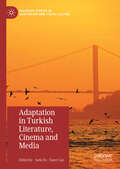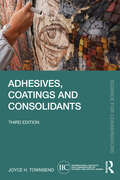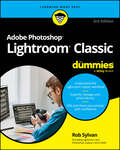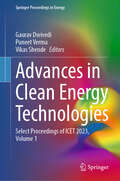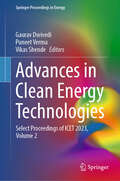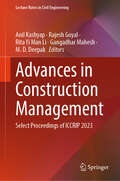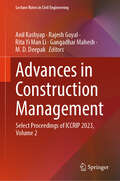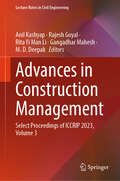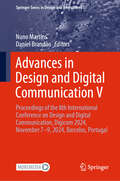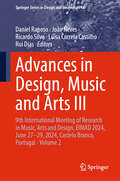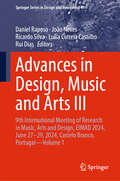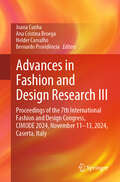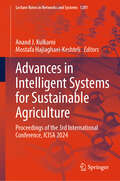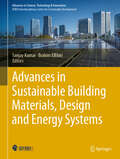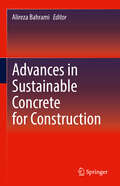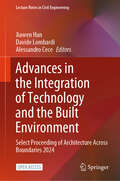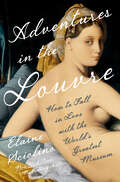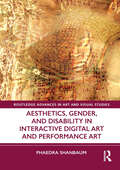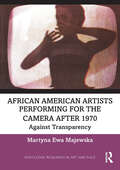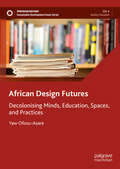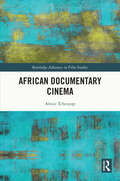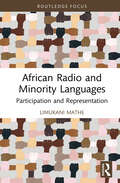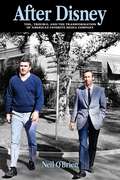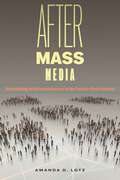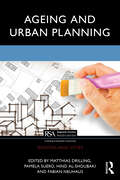- Table View
- List View
Adaptation in Turkish Literature, Cinema and Media (Palgrave Studies in Adaptation and Visual Culture)
by Taner Can Seda ÖzThis edited collection provides a comprehensive exploration of key trends and methodologies in adaptation within the Turkish context, examining how socio-political and economic conditions shape the interaction between texts, cultures, and media industries. With thirteen essays covering adaptation topics from the early 1940s to the present, the collection addresses a diverse range of subjects, including novel-to-film adaptations, film remakes, television series, documentary dramas, stage adaptations, comic books, and the music industry.
Adhesives, Coatings and Consolidants (Science for Conservators)
by Joyce H. TownsendThis new edition titled Adhesives, Coatings and Consolidants discusses the chemical, physical, and optical properties that influence the selection of adhesives, coatings, and consolidants used in the conservation of cultural heritage objects made from a wide range of materials.The structured text guides readers through the concepts that underpin the selection of the material to use for a given object, when making a join, applying a coating, or consolidating a fragile surface. Widely used conservation materials today are mentioned in the context of the desirable properties that account for their popularity, while examples of those used in the past and likely to be found on previously treated objects are also discussed. This volume is not a recipe book. It is a basic primer and an aid to the assimilation of concepts that will become embedded in decision-making by conservation professionals. Adhesives are discussed first and in the most detail, followed by coatings. The section on consolidants has been extended to reflect developments in treatment and ongoing research into more effective and more sustainable products, such as nanomaterials, that offer new possibilities for the treatment of challenging objects. A list of further reading and some practical exercises are included, along with a comprehensive index.Thoroughly updated to reflect the most recent research, Adhesives, Coatings and Consolidants remains a crucial resource for those beginning a course of study in practical conservation and as a refresher for emerging and mid-career conservators.
Adobe Photoshop Lightroom Classic For Dummies
by Rob SylvanThe most up-to-date manual for using Adobe's gold standard photo workflow software Adobe Photoshop Lightroom Classic For Dummies is the perfect companion for photographers looking to make the most of this powerhouse software. Lightroom Classic lets you edit, organize, and share large volumes of digital photos, so you can spend less time in front of the computer and more time behind the lens. With this book, you'll learn the program's fundamentals and discover the latest features and updates'including improved Masking tools, AI-based tools, and the new Lens Blur feature. Discover the tools and processes that make the most sense for you, and get pro tips for taking your photos to the next level. Learn your way around the Lightroom Classic interface Expertly manage your photo library Edit and share your photos with confidence Make your photos even better with new editing tools This popular Dummies guide is great for anyone who needs a primer on the essentials of Lightroom Classic for personal or professional use.
Advances in Clean Energy Technologies: Select Proceedings of ICET 2023, Volume 1 (Springer Proceedings in Energy)
by Puneet Verma Gaurav Dwivedi Vikas ShendeThis book presents select peer-reviewed proceedings of the International Conference on Innovations in Clean Energy Technologies (ICET 2023) and examines a range of durable, energy-efficient, and next-generation smart green technologies for a sustainable future by reflecting on the trends, advances, and developments taking place across the globe. The topics covered include smart technologies-based products, energy-efficient systems, solar and wind energy, carbon sequestration, green transportation, green buildings, energy material, biomass energy, smart cities, hydropower, bio-energy, and fuel cells. The book also discusses various performance attributes of these clean energy technologies and their workability and carbon footprint. The book is a valuable reference for beginners, researchers, and professionals interested in clean energy technologies.
Advances in Clean Energy Technologies: Select Proceedings of ICET 2023, Volume 2 (Springer Proceedings in Energy)
by Puneet Verma Gaurav Dwivedi Vikas ShendeThis book contains select peer-reviewed proceedings from the International Conference on Innovations in Clean Energy Technologies (ICET 2023). It explores a variety of durable, energy-efficient, and next-generation smart green technologies aimed at promoting a sustainable future. The topics covered include smart technology-based products, energy-efficient systems, solar and wind energy, carbon sequestration, green transportation, green buildings, energy materials, biomass energy, smart cities, hydropower, bio-energy, and fuel cells. The book also discusses the performance attributes of these clean energy technologies, as well as their workability and carbon footprint. It is a valuable reference for beginners, researchers, and professionals interested in clean energy technologies.
Advances in Construction Management: Select Proceedings of ICCRIP 2023 (Lecture Notes in Civil Engineering #238)
by Anil Kashyap Rita Yi Man Li Rajesh Goyal Gangadhar Mahesh M. D. DeepakThis book presents the select proceedings of the 7th International Conference on Construction, Real Estate, Infrastructure, and Project Management (ICCRIP 2023) and explores recent and innovative developments in all aspects of the CRIP sector. The book covers various issues in construction management, advancements in construction technologies and materials, sustainable construction practices, managerial issues in the CRIP sector, construction 4.0, project management, real estate and urban planning, energy, environment and sustainability. The book will be useful for researchers and professionals involved in construction management, civil engineering and related fields.
Advances in Construction Management: Select Proceedings of ICCRIP 2023, Volume 2 (Lecture Notes in Civil Engineering #601)
by Anil Kashyap Rita Yi Man Li Rajesh Goyal Gangadhar Mahesh M. D. DeepakThis book presents the select proceedings of the 7th International Conference on Construction, Real Estate, Infrastructure, and Project Management (ICCRIP 2023) and explores recent and innovative developments in all aspects of the CRIP sector. The book covers various issues in construction management, advancements in construction technologies and materials, sustainable construction practices, managerial issues in the CRIP sector, construction 4.0, project management, real estate and urban planning, energy, environment and sustainability. The book will be useful for researchers and professionals involved in construction management, civil engineering and related fields.
Advances in Construction Management: Select Proceedings of ICCRIP 2023, Volume 3 (Lecture Notes in Civil Engineering #618)
by Anil Kashyap Rita Yi Man Li Rajesh Goyal Gangadhar Mahesh M. D. DeepakThis book presents the select proceedings of the 7th International Conference on Construction, Real Estate, Infrastructure, and Project Management (ICCRIP 2023) and explores recent and innovative developments in all aspects of the CRIP sector. The book covers various issues in construction management, advancements in construction technologies and materials, sustainable construction practices, managerial issues in the CRIP sector, construction 4.0, project management, real estate and urban planning, energy, environment and sustainability. The book will be useful for researchers and professionals involved in construction management, civil engineering and related fields.
Advances in Design and Digital Communication V: Proceedings of the 8th International Conference on Design and Digital Communication, Digicom 2024, November 7–9, 2024, Barcelos, Portugal (Springer Series in Design and Innovation #51)
by Nuno Martins Daniel BrandãoThis book reports on research findings and practical lessons featuring advances in the areas of digital and interaction design, graphic design and branding, design education, society and communication in design practice, and related ones. Gathering the proceedings of the 8th International Conference on Digital Design and Communication, Digicom 2024, held on November 7-9 2024, as a hybrid event, in/from Barcelos, Portugal, this book continues the tradition of the previous ones reporting on new design strategies to foster digital communication within and between the society, institutions and brands. By highlighting innovative ideas and reporting on multidisciplinary projects, it offers a source of inspiration for designers of all kinds, including graphic and web designers, UI, UX and social media designers, and to researchers, advertisers, artists, and brand and corporate communication managers alike.
Advances in Design, Music and Arts III: 9th International Meeting of Research in Music, Arts and Design, EIMAD 2024, June 27–29, 2024, Castelo Branco, Portugal - Volume 2 (Springer Series in Design and Innovation #48)
by Daniel Raposo João Neves Luísa Correia Castilho Rui Dias Ricardo SilvaThis book presents cutting-edge methods and findings that are expected to contribute to significant advances in the areas of communication design, fashion design, interior design and product design, as well as musicology and other related areas. It especially focuses on the role of digital technologies, and on strategies fostering creativity, collaboration, education, as well as sustainability and accessibility in the broadly-intended field of design. Gathering the second volume of the proceedings of the 9th EIMAD conference, held in hybrid format on June 27–29, 2023, and organized by the School of Applied Arts of the Instituto Politécnico de Castelo Branco, in Portugal, this book offers a timely guide and a source of inspiration for designers of all kinds, advertisers, artists, and entrepreneurs, as well as educators and communication managers.
Advances in Design, Music and Arts III: 9th International Meeting of Research in Music, Arts and Design, EIMAD 2024, June 27–29, 2024, Castelo Branco, Portugal—Volume 1 (Springer Series in Design and Innovation #49)
by Daniel Raposo João Neves Luísa Correia Castilho Rui Dias Ricardo SilvaThis book presents cutting-edge methods and findings that are expected to contribute to significant advances in the areas of communication design, fashion design, interior design and product design, as well as musicology and other related areas. It especially focuses on the role of digital technologies, and on strategies fostering creativity, collaboration, education, as well as sustainability and accessibility in the broadly-intended field of design. Gathering the first volume of the proceedings of the 9th EIMAD conference, held in hybrid format on June 27–29, 2023, and organized by the School of Applied Arts of the Instituto Politécnico de Castelo Branco, in Portugal, this book offers a timely guide and a source of inspiration for designers of all kinds, advertisers, artists, and entrepreneurs, as well as educators and communication managers.
Advances in Fashion and Design Research III: Proceedings of the 7th International Fashion and Design Congress, CIMODE 2024, November 11–13, 2024, Caserta, Italy
by Ana Cristina Broega Joana Cunha Helder Carvalho Bernardo ProvidênciaThis book offers a multidisciplinary perspective on research and developments at the interface between industrial design, textile engineering and fashion. It covers advances in fashion and product design, and in textile production alike, reporting on sustainable industrial procedures, ergonomics research and practices, new materials and circular design, as well as issues in marketing, communication, and education. A special emphasis is given to the theme of fashion's cultural and productive landscapes and to sustainable strategies in design. Gathering the proceedings of the 7th International Fashion and Design Congress, CIMODE 2024, held on November 11–13, 2024, in Caserta, Italy, this book offers extensive information and a source of inspiration to both researchers and professionals in the field of fashion, design, engineering, communication as well as education.
Advances in Intelligent Systems for Sustainable Agriculture: Proceedings of the 3rd International Conference, ICISA 2024 (Lecture Notes in Networks and Systems #1201)
by Anand J. Kulkarni Mostafa Hajiaghaei-KeshteliThis book presents the select proceedings of the 3rd International Conference on Intelligent Systems and Applications 2023. The theme of this conference is ‘Intelligent Systems for Agricultural Applications'. It covers the topics of intelligent systems in multiple aspects such as sustainable crop production, weather prediction, post-harvest management and agro-processing, digitalization and automation of agri equipment, agriculture warehouse and supply chain management, yield prediction, and quality assessment. The book is useful for researchers and professionals interested in the broad field of artificial intelligence and machine learning.
Advances in Sustainable Building Materials, Design and Energy Systems (Advances in Science, Technology & Innovation)
by Sanjay Kumar Brahim ElBhiriThis book is a great opportunity to make the research community discuss the dangerous environmental challenges such as climate change and its huge effects in addition to the world's reliance on fossil fuel and non-renewable resources. In recent years, the authors have been focused on the advancements of technology and how it can improve our lives, but the authors often overlook the fact that it is creating an unsustainable approach that comes at a high cost which makes a sustainable approach to cities necessary, focusing on accessible public transport, energy, water, and food security, and regenerating compact fabric areas. To discuss how to reach this sustainable approach, IEREK held the Advances in Energy Research, Materials Science and Built Environment (EMBE) conference from October 3 to 4, 2024, with attendees from all over the world. It provides an opportunity to exchange ideas and solutions on urban planning, sustainable architecture, climate change mitigation, and innovative design. The EMBE conference hosts a variety of knowledgeable keynote speakers and researchers who discussed the integration of technology in sustainable urban planning, green urbanism, preservation of coastal areas, innovative renewable materials, and responsive architecture. The book covers a wide range of scientific knowledge that can lead humanity toward a sustainable and greener future.
Advances in Sustainable Concrete for Construction
by Alireza BahramiThis book offers groundbreaking insights into transforming the concrete industry with innovative, environmentally conscious solutions. It explores the latest advancements in sustainable technologies, including climate-improved concrete, green binders, recycled materials, and high-performance composites. It also covers the optimization of reinforced concrete structures, load-bearing columns and beams replacements, as well as non-destructive testing methods for predicting concrete performance. Additionally, it investigates engineered cementitious composites, internally cured concrete, and industrial by-products to address pressing environmental challenges in construction. An indispensable reference for engineers, architects, and researchers shaping the future of sustainable infrastructure and reducing carbon footprints
Advances in the Integration of Technology and the Built Environment: Select Proceeding of Architecture Across Boundaries 2024 (Lecture Notes in Civil Engineering #593)
by Jiawen Han Davide Lombardi Alessandro CeceThis open access book will be a compilation of selected papers from the 2nd International Conference on Architecture Across Boundaries (AAB2024). The work focuses on novel integration of technology into the built environment in the areas of space syntax, digital fabrication, computational design, professional models, eco-system and urban morphology domains. The content makes valuable contributions to academic researchers and educators in the university and practitioners in the industry, who have been working in or with a particular awareness of the different types of boundaries, including technological, cultural and physical boundaries in the research on built environments. This book will work as a good reference for academics and professionals conducting interdisciplinary research in an effort to understand and achieve a better hybrid environment.
Adventures in the Louvre: How to Fall in Love with the World's Greatest Museum
by Elaine SciolinoA former New York Times Paris bureau chief explores the Louvre, offering an intimate journey of discovery and revelation. The Louvre is the most famous museum in the world, attracting millions of visitors every year with its masterpieces. In Adventures in the Louvre, Elaine Sciolino immerses herself in this magical space and helps us fall in love with what was once a forbidding fortress. Exploring galleries, basements, rooftops, and gardens, Sciolino demystifies the Louvre, introducing us to her favorite artworks, both legendary and overlooked, and to the people who are the museum’s lifeblood: the curators, the artisans producing frames and engravings, the builders overseeing restorations, the firefighters protecting the aging structure. Blending investigative journalism, travelogue, history, and memoir, Sciolino walks her readers through the museum’s front gates and immerses them in its irresistible, engrossing world of beauty and culture. Adventures in the Louvre reveals the secrets of this grand monument of Paris and basks in its timeless, seductive power.
Aesthetics, Gender, and Disability in Interactive Digital Art and Performance Art (Routledge Advances in Art and Visual Studies)
by Phaedra ShanbaumThis book explores the tensions between aesthetics, gender, and disability in contemporary digital media installations and performance art. Notions of agency and subjectivity are connected to four contemporary political issues (artificial intelligence, migration and political violence, contemporary medical technologies and practices, and the Anthropocene) and analyzed against a Western legacy of utopian and dystopian ideas and desires that have shaped, and continue to shape, what it means to be human. The book’s main argument is that agency and subjectivity are not universal attributes; rather they are socio-material entanglements and contextually bound enactments that are strategically negotiated by the subject. Thus, they involve conflict, struggle, and other forms of resistance.The book will be of interest to scholars working in art history, media and cultural studies, disability studies, and gender studies.
African American Artists Performing for the Camera After 1970: Against Transparency (Routledge Research in Art and Race)
by Martyna Ewa MajewskaThis study demonstrates how African American artists active since the 1970s have instrumentalized performance for the camera to intervene in existing representations of Black and Brown people in America and beyond.Majewska argues that producing carefully designed photographs, films, and videos via performance became a key strategy for dismantling the conceptions of race and gender fixed by US popular culture, jurisprudence, and pseudoscience. Studying the work of Adrian Piper, Glenn Ligon, Lyle Ashton Harris, Senga Nengudi, Maren Hassinger, Howardena Pindell, David Hammons, and Pope.L, this book examines the ways in which these artists incorporate their bodies and personal experience into their respective performances, simultaneously courting and foreclosing autobiographical readings. The strategies examined here, while diverse, all challenge conventional interpretations of performance art—especially those overdetermined by race, gender, and sexuality.The book will be of interest to scholars working in art history, performance studies, photography, and African American studies.
African Design Futures: Decolonising Minds, Education, Spaces, and Practices (Sustainable Development Goals Series)
by Yaw Ofosu-AsareThis book responds to the question "Is it time to reimagine design education in Africa and decolonise our creative future?" The proposed volume is designed to provide a source of inspiration to readers in imagining their own futures within fields of Creative industries such as performative art, architecture design, industrial design, media production, drawing and illustration, filmmaking, design, documentary, virtual reality, and others. With a focus on decolonising design education in Africa, this book will challenge the dominant capitalist narrative and centre on the needs of African communities. It will provide insights into the challenges and opportunities of decolonising design education and propose alternative models for design education that promote social and environmental sustainability, cultural preservation, and community empowerment. Collectively, the proposed book's accounts bring to life the career possibilities within a rapidly expanding global sector of creativity and innovation with immense cultural, social, political, and economic impact. By exploring new models of creative practice and education that centre on social impact, cultural relevance, and community empowerment, this book will inspire readers to think critically about their own futures in the Creative Industries in Africa.
African Documentary Cinema: Beyond Representation (Routledge Advances in Film Studies)
by Alexie TcheuyapAfrican Documentary Cinema investigates the inception and trajectory of contemporary documentary filmmaking in sub-Saharan African countries and their diasporas. The book challenges critical paradigms that have long prevailed in African film criticism, shedding light on the diverse discourses and evolving aesthetic trends present within documentary films.Situating his analysis within the context of the significant transformation of the African film industry, the author focuses on the development, diversity, and shifting dynamics that have impacted contemporary documentary cinema. Examining the historical, political, sociological, economic, and cultural factors that have facilitated the rise of documentary films—especially those created by female documentarians—the book assesses the emergence of documentary filmmakers spanning different generations. Their training, practices, and innovative perspectives on social, political, and environmental issues ultimately give rise to new frameworks for understanding the bio-documentary genre, issues of gender discrimination, LGBTQIA+ identities, environmental trauma, genocide, and memory on the African continent.This ground-breaking study offers new insight into a rapidly expanding topic and will appeal to students and scholars in the fields of film studies, documentary film, media industry studies, African studies, French, postcolonial studies, politics, and cultural studies.
African Radio and Minority Languages: Participation and Representation (Routledge African Media, Culture and Communication Studies)
by Limukani MatheWithin Africa, radio provides an important platform for accommodating diverse linguistic groups and enabling speakers to express themselves in their own local languages. This book investigates how radio broadcasting across the continent provides a platform for cultural participation and the representation of minority language speakers in a contested public sphere. In African media, a fierce contest wages for representation and participation, in which majority languages often emerge at the exclusion of minority ethnolinguistic groups. This book considers the important role that radio can play in broadcasting in minority languages. Drawing on in-depth original analysis, ethnographic observation and interviews with minority language radio hosts and guests from across South Africa, Zimbabwe, Nigeria, Malawi, Namibia, Mozambique, Lesotho and Kenya, this book considers to what extent African radio is accommodative of minority languages and what the challenges and prospects are for this. Ultimately, the book argues that radio’s three-tier system of broadcasting through analogue and digital radio leaves the medium of radio particularly well placed to provide equal access for ethnolinguistic groups in Africa.This ambitious and broad-ranging study will be an essential read for scholars and students of media studies and sociolinguistics in Africa.
After Disney: Toil, Trouble, and the Transformation of America's Favorite Media Company
by Neil O'BrienThe untold succession struggle at Walt Disney Productions following the death of its founder, and the generational transformation which led to the birth of the modern multibillion-dollar animation industry.Walt Disney left behind big dreams when he died in 1966. Perhaps none was greater than the hope that his son-in-law, Ron Miller, would someday run his studio. Under Miller&’s leadership, Disney expanded into new frontiers: global theme parks, computer animation, cable television, home video, and video games. Despite these innovations, Ron struggled to expand the Disney brand beyond its midcentury image of wholesome family entertainment, even as times and tastes evolved. Tensions between Miller and Walt&’s nephew, Roy E. Disney, threatened to destroy the company, leading Wall Street &“Gordon Gekko&” types to come after Mickey Mouse. At the same time, the aging Animation Department—once the core of Walt&’s business—was one memo away from shutting down forever. Rather, thanks to the radical efforts of Walt&’s veterans to recruit and nurture young talent, it was revived by this sudden influx of artists who would go on to revolutionize the film industry. Additionally, this new generation would prove over time that animation was so much more than just kids&’ stuff—it was a multibillion dollar industry. This is the upstairs-downstairs story of the executives and animators who clashed and collaborated to keep America&’s most storied company alive during the most uncertain period in its one hundred year history.
After Mass Media: Storytelling for Microaudiences in the Twenty-First Century (Critical Cultural Communication)
by Amanda D. LotzExplores the cultural role of screen storytelling in societyWith significant evolutions in digital technologies and media distribution in the past two decades, the business of storytelling through screens has shifted dramatically. In the past, blockbuster movies and TV shows like Friends aimed first for domestic mass audiences, although the biggest hits circulated globally. Now, transnational distribution plays a primary role and imagined audiences are global. At the same time, the once-mass audience has significantly fragmented to enable an expansion in the range of commercially viable stories, as evident in series as varied as Atlanta, Better Things, and dozens of others that are not widely known, but deeply loved by their microaudiences.Delving into the changing landscape of commercial screen storytelling, After Mass Media explores how industrial shifts and technological advancements have remade the narrative landscape over the past two decades. Television and movies have long shaped society, whether by telling us about the worlds around us or far away. By examining the internationalization of screen businesses, the rise of streaming services with multi-territory reach, and the stories made for this environment, this book sheds light on the profound transformations in television and film production and circulation. With a keen focus on major changes in the types of screen stories being told, Amanda D. Lotz unravels the industrial roots that made these transformations possible, challenges some conventional distinctions of screen storytelling, and provides new conceptual tools to make sense of the abundance and range of screen stories on offer.Through its comprehensive analysis, After Mass Media exposes how contemporary industrial dynamics, particularly the erosion of traditional distribution models based on geography and mass audience reach, have far-reaching implications for our understanding of national video cultures.
Ageing and Urban Planning (Regions and Cities)
by Fabian Neuhaus Matthias Drilling Hind Al-Shoubaki Pamela SueroAgeing and Urban Planning provides a critical analysis of urban planning in the face of demographic change. It emphasises the importance of international approaches and practices to address age-friendly planning. This process requires collaboration between professionals and the community, going beyond mere functionality to connect the micro and macro scales at the city, region, nation, and the global level.With an interdisciplinary and intersectional approach, the book draws on analytical lenses from architecture, gerontology, geography, sociology, and social and urban planning. It offers a thorough critique of popular narratives surrounding ageing and urban planning while presenting diverse case studies on a variety of spatial scales. The volume also covers the history of urban design for ageing and inclusivity in planning governance, as well as a critical look at the concept of "ageing in place" from the perspective of urban planning. The book offers a comprehensive selection of in-depth photos and figures from urban design studios, planning processes, and real-life scenarios. This collection provides a unique network of inspiring ideas. The book ultimately seeks to supplement the debate and promote a broader reflection about the transformations required in urban planning, given the opportunities and challenges related to a world with increased longevity.This valuable resource is recommended for advanced students, researchers, and policymakers in the fields of urban planning, age-related disciplines and professions, and social policy.
